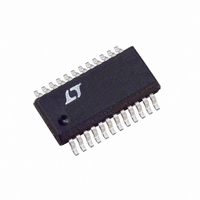LTC3736EGN Linear Technology, LTC3736EGN Datasheet - Page 11

LTC3736EGN
Manufacturer Part Number
LTC3736EGN
Description
IC CTRLR SW SYNC DUAL 2PH 24SSOP
Manufacturer
Linear Technology
Series
PolyPhase®r
Type
Step-Down (Buck)r
Datasheet
1.LTC3736EGNPBF.pdf
(28 pages)
Specifications of LTC3736EGN
Internal Switch(s)
No
Synchronous Rectifier
Yes
Number Of Outputs
2
Voltage - Output
0.6 ~ 9.8 V
Current - Output
1A
Frequency - Switching
550kHz ~ 750kHz
Voltage - Input
2.75 ~ 9.8 V
Operating Temperature
-40°C ~ 85°C
Mounting Type
Surface Mount
Package / Case
24-SSOP
Lead Free Status / RoHS Status
Contains lead / RoHS non-compliant
Power - Output
-
Available stocks
Company
Part Number
Manufacturer
Quantity
Price
Company:
Part Number:
LTC3736EGN
Manufacturer:
Linear Technology
Quantity:
135
Company:
Part Number:
LTC3736EGN
Manufacturer:
ST
Quantity:
766
Part Number:
LTC3736EGN
Manufacturer:
LT/凌特
Quantity:
20 000
Part Number:
LTC3736EGN#PBF
Manufacturer:
LINEAR/凌特
Quantity:
20 000
Part Number:
LTC3736EGN-2
Manufacturer:
LINEAR/凌特
Quantity:
20 000
Part Number:
LTC3736EGN-2#PBF
Manufacturer:
ADI/亚德诺
Quantity:
20 000
OPERATIO
When a controller is enabled for Burst Mode operation, the
inductor current is not allowed to reverse. Hence, the
controller operates discontinuously. The reverse current
comparator (RICMP) senses the drain-to-source voltage
of the bottom external N-channel MOSFET. This MOSFET
is turned off just before the inductor current reaches zero,
preventing it from reversing and going negative.
In forced continuous operation, the inductor current is
allowed to reverse at light loads or under large transient
conditions. The peak inductor current is determined by the
voltage on the I
every cycle (constant frequency) regardless of the I
voltage. In this mode, the efficiency at light loads is lower
than in Burst Mode operation. However, continuous mode
has the advantages of lower output ripple and less inter-
ference with audio circuitry.
When the SYNC/FCB pin is clocked by an external clock
source to use the phase-locked loop (see Frequency
Selection and Phase-Locked Loop), the LTC3736 operates
in PWM pulse skipping mode at light loads. In this mode,
the current comparator I
several cycles and force the external P-channel MOSFET to
stay off for the same number of cycles. The inductor
current is not allowed to reverse, though (discontinuous
operation). This mode, like forced continuous operation,
exhibits low output ripple as well as low audio noise and
reduced RF interference as compared to Burst Mode
operation. However, it provides low current efficiency
higher than forced continuous mode, but not nearly as
high as Burst Mode operation. During start-up or a short-
circuit condition (V
operates in pulse skipping mode (no current reversal
allowed), regardless of the state of the SYNC/FCB pin.
Short-Circuit Protection
When an output is shorted to ground (V
switching frequency of that controller is reduced to 1/5 of
the normal operating frequency. The other controller is
unaffected and maintains normal operation.
The short-circuit threshold on V
of 0.12V and a fraction of the voltage on the TRACK pin.
This also allows V
easily. Note that if V
TH
U
pin. The P-channel MOSFET is turned on
OUT2
FB1
(Refer to Functional Diagram)
to start up and track V
or V
OUT1
CMP
FB2
is truly short-circuited
FB2
may remain tripped for
≤ 0.54V), the LTC3736
is based on the smaller
FB
< 0.12V), the
OUT1
TH
more
pin
(V
V
the TRACK pin.
Output Overvoltage Protection
As a further protection, the overvoltage comparator (OV)
guards against transient overshoots, as well as other more
serious conditions that may overvoltage the output. When
the feedback voltage on the V
above the reference voltage of 0.6V, the external P-chan-
nel MOSFET is turned off and the N-channel MOSFET is
turned on until the overvoltage is cleared.
Frequency Selection and Phase-Locked Loop
(PLLLPF and SYNC/FCB Pins)
The selection of switching frequency is a tradeoff between
efficiency and component size. Low frequency operation
increases efficiency by reducing MOSFET switching losses,
but requires larger inductance and/or capacitance to main-
tain low output ripple voltage.
The switching frequency of the LTC3736’s controllers can
be selected using the PLLLPF pin.
If the SYNC/FCB is not being driven by an external clock
source, the PLLLPF can be floated, tied to V
SGND to select 550kHz, 750kHz or 300kHz respectively.
A phase-locked loop (PLL) is available on the LTC3736 to
synchronize the internal oscillator to an external clock
source that connected to the SYNC/FCB pin. In this case,
a series RC should be connected between the PLLLPF pin
and SGND to serve as the PLL’s loop filter. The LTC3736
phase detector adjusts the voltage on the PLLLPF pin to
align the turn-on of controller 1’s external P-channel
MOSFET to the rising edge of the synchronizing signal.
Thus, the turn-on of controller 2’s external P-channel
MOSFET is 180 degrees out of phase with the rising edge
of the external clock source.
The typical capture range of the LTC3736’s phase-locked
loop is from approximately 200kHz to 1MHz, and is
guaranteed over temperature to be between 250kHz and
850kHz. In other words, the LTC3736’s PLL is guaranteed
to lock to an external clock source whose frequency is
between 250kHz and 850kHz.
OUT2
OUT1
to 0V if a resistor divider on V
= V
FB1
= 0V), then the LTC3736 will try to regulate
FB
pin has risen 13.33%
OUT1
LTC3736
is connected to
IN
or tied to
11
3736fa














